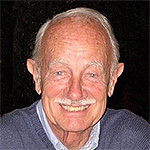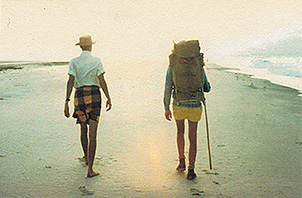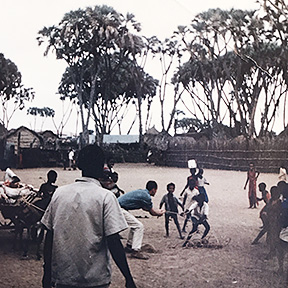An RPCV remembers Peace Corps staff member Bob Blackburn (Somalia)
Living a Life
by Don Beil (Somalia 1964–66)
Robert (“Bob”) W. Blackburn (Deputy Director/Somalia 1964–66), 81, died Saturday, September 10, 2016.
 For several weeks before his death he knew his heart was giving out, and he spoke openly of the wonderful life he had enjoyed, and the realization that it was coming to an end. On Friday evening he felt it was imminent and all of his immediate family gathered to spend that evening talking warmly with him until past midnight. In the early morning they found that Bob had died peacefully in his sleep.
For several weeks before his death he knew his heart was giving out, and he spoke openly of the wonderful life he had enjoyed, and the realization that it was coming to an end. On Friday evening he felt it was imminent and all of his immediate family gathered to spend that evening talking warmly with him until past midnight. In the early morning they found that Bob had died peacefully in his sleep.
Those of use who knew him can take comfort in his open acceptance of the inevitable and repeated assurances of his appreciation for the life he enjoyed with each of us. Bob spoke to those near him in his last days in such a calm manner that he was comforting us, thinking of others as he had done throughout his life.
With his death, a piece of me — and those who knew him — also died. Fortunately he also lives on in each of us as well.
The Peace Corps, and his time in Somalia, was a central part of Bob’s life. His SOMALIA license plate stood as an announcement to the world of the pride he felt in the accomplishments of the Volunteers he served while managing the program in the North in Somalia from 1964 to 1966.
I was one of those Volunteers in Somalia 2, and how fortuitous it was that I was placed in Hargeisa where Bob and his wife Barbara were also stationed. So, our friendship began 52 years ago and continued until his death. He was best man at at my wife, Marian, and my wedding. We were in constant touch during that half century. Although I lived most of that time on the East coast, and most of that time he was in Oakland CA, we managed to see each other regularly. About eight years ago Marian moved to Oakland to be near both of our sons who preceded us to the Bay area. The Blackburns also being here was a big part of our decision to resettle in Oakland. I commuted to the East for about 6 of those years and moved out here full-time three years ago. Marian and I constantly saw the Bob and Barbara, often several times a week.
Those who have commented on him have universally talked of his wit. Those unfamiliar with it might enjoy an exchange I had while visiting him a day or two before he died. I was deeply concerned about him, and I asked “Are you comfortable?” Bob’s reply was a shrug and then he said: “I make a living.” Classic Bob until the end.
When I recall my days in Somalia two images come to mind. Bob and I, along with a third PCV, took a three-day hike along the Northern coast of Somalia. The photo of Bob and me that has always been on my dresser, shows the two of us in our Somali “skirts” walking quietly away from the camera.

The second image was taken when a handful of PCVs along with Bob took a ‘trade truck’ from Hargeisa to Mogadishu. It was an eight-day ride in the back of a large open back truck that started with perhaps a dozen people in the back and ended with roughly 25 people and a goat or two. We drove day and night, all over open ground as Somalia had only several miles of paved roads in the entire country. The photo shows Bob, at one of our stops engaging – romping is a better word —with 8–10 young kids in a village along the way. They were so happy!

. . . and playing tug-of-war!
Bob repeated that behavior over and over again. We’ve had hundreds of dinners out with Bob and Barbara. It was a rare evening when Bob did not spend time at other tables engaged with unknown others, whomever might be at the restaurant. I can’t count the number of times that strangers have asked him to share in their birthday cake as Bob went over to chat with the birthday boy or girl or adult. What charm he had!
Those who only know him on the West coast are not familiar with his Peace Corps related activities back East. Upon his return from the Peace Corps in the late 1960s he went to work in the Philadelphia school system. He hand-signed several thousand letters to Volunteers at their overseas posts who were near the completion of their service, offering them contracts to teach in the Philadelphia inner city schools. His recruitment efforts landed 175 Returned Peace Corps Volunteers jobs, sight unseen. He spoke of his recruitment activity before the House of Representatives, saying “we regard the Volunteers as the single best source of top-flight educators available to us anywhere.”
You are at Peace Corps Worldwide so you’re no doubt readers. Bob was such a talented writer. For a sampling of his writing, go no farther than than a letter published at the Peace Corps Writers site
A few paragraphs from the letter home at that site follow:
To friends, as usual, through the mimeograph (darkly):
Well, the next thing we knew we were at the other end of the world, then at the edge, then OFF. (The edge is quite sharp, as the early geographers knew.) Over and around we tumbled for what seemed like seven months. Then to rest somewhere — your world winking eons away — in a land called S-O-M-A-L-I-A. Those who dwell here are strange indeed. Neckties and Living Bras do not bind them, and David Suskind never slept here. Of “cultural deprivation” they know not. Vehicles are for going someplace. The nearest thing to a national sex symbol is a species of fat-tailed sheep, and they wouldn’t know a foundation grant from a camel grunt.
They do know about Selma, and Lt. Col. Aleksei Leonov, and U.S. arms to Ethiopia. And John F. Kennedy, and Ray Charles’ “Hit the Road, Jack,” and, more and more. And the “Peace Corpse”— whether as friend, alien agent, or sponsor of the strangest creatures on two legs.
…
Yet the real problems, unsurprisingly, relate to people: Volunteers who are taking this occasion to, among other things, grow up; officials reared and educated under colonialism, upset and distrustful as Volunteers move away from the roles formerly assumed by white foreigners to seek close associations with Somalia; the few lingering expatriates (advisors, business people) who watch with revulsion as Peace Corps people do things Westerners simply do not do, not the least of which is removing the color bar in the remaining “European” gathering spot.
I have no idea how many RPCVs obtained their jobs because of recommendation letters Bob wrote for them, but I do know it numbers in the scores, and probably includes a large percentage of the Somalia 2s.
The Somalia 2s, all 58 of us, served out our full two-year assignment in Somalia, with one Volunteer leaving a few weeks early on a medical evacuation to Germany. Those familiar with ‘early termination’ in the Peace Corps know how unusual that was. Bob and Fred Thomas (who sadly also died recently, nearby in Berkeley), our country director, were directly responsible. Such strong staffers provided extraordinary support to the Volunteers.
At some point he said to Bob, who relished pleasing me by retelling it, that Fred had said: “You talk to Blackburn, you talk to Beil, it’s all the same thing.”
I’ll share with you that a few hours before Bob died we spoke on the phone and I told him I loved him. I also told him that Fred’s comment was the greatest compliment I had ever received and the thought that I could be even a bit like Bob was heartwarming to me. We were both in tears.
A very sad time, but all are grateful that Bob died peacefully, with no pain, and after a relatively short time of really being weak.
So, yes, he’s gone. And yes, a part of me has died. And yes, Bob replied to my question “Are you comfortable?”by probably quoting someone like Henny Youngman that “I make a living.”
But not only did Bob make a living but he really “lived a life.”
His obituary follows and can also be found on-line at a site that allows you to leave your own thoughts as well.
Robert (“Bob”) W. Blackburn, 81, died peacefully in his sleep on Saturday, September 10, 2016. A longtime resident of Oakland, he is survived by his wife Barbara, children Christopher and Samantha, and granddaughter Maya.
Bob touched many lives with his warmth, irreverent humor, and passion for social justice. He served as a Peace Corp director in Somalia in the sixties. After working in civil rights and school reform in Philadelphia, he was Deputy and later Acting Superintendent of Oakland Unified School District. In 1973 he survived an assassination attempt by the SLA, but lost his close friend Marcus Foster. For many years he taught educational leadership at Cal State East Bay and UC Berkeley. His legacy lives on in the students he mentored, inspiring them to become equity-minded teachers, principals, and superintendents.
A memorial will be held at 2pm on Sunday, October 9, 2016, at the Snow Building, Oakland Zoo. His family is asking that anyone who wishes to honor his life consider making contributions to the Oakland Zoo or the Marcus Foster Education Institute.
Lovely piece, Don….So well remembered….
An excellent history narrative with a lifedance step that smiles from the page.
Bob will remain a “graceful ghost”-a deeply honored presence in all of our lives, still alive because we hold him in our hearts and minds as one of the profound role models of our lives. Don Biel’s account of the trade truck trip from Hargeisa to Mog brought back some aches and pains I remember from a similar trip I took a year or so later, and of another, down the coast from my post in Hobya by truck to Mog….and the children who came out from everywhere to see the white people…Bob attracted those children like a Pied Piper, and I am honored to be considered one who followed in his footsteps.
Don’s piece captures the essence of Bob. He was a great story teller as well and his account of bringing Ranjit the cheetah through the Rome airport was hilarious. As one of the Somali 4s we were part of Bob’s great experiment to bring 40+ PCVs fresh from the States (and many of us had never traveled outside our country) to Hargeisa in the North, and then by Police Transport trucks to Taleh, the middle of no where. The idea was to get acclimated to the country, work with 45 or so Somali Police in “cleaning up” the fort built by Sayeed Mohamed Abdille Hassan and bombed by the British around 1919 (the first use of aerial bombardment on the African continent) and perhaps toughen us up for the two years ahead.
On the way to Taleh, over dusty pot-hole marked roads we stayed at the German Technical Institute in Burro, a small town about midway between Hargeisa and Taleh. Bob would tell the story with great relish and a pitch perfect German accent, how the two giant Mercedes troop transports pulled into the Institute’s compound and a discombobulated voice hidden by the glare of a Coleman lamp, called out- “Welcome to the German Technical Institute,” to which an anonymous PCV shouted back- “We are not getting off the truck until you tell us what you have done with the others.”
As late as our RPCV reunion last year in Berkeley, we still referred to Bob as “our fearless leader.” He was our leader by example, leading us with his integrity, grit, sense of humor, his social conscience and most of all, his humanity and sense of decency. These are the characteristics which live on in all of us who knew him and hopefully make us better human beings.
Another Peace Corps life well lived and well remembered by Don.
I was a member of group three. I taught at the primary school in Borama. Mr. Blackburn helped me in many ways, not only in Somalia, but also on returning to th US. He had a couple of horses, gave me one, which we managed to get to Borama. Mr. Blackburn remained as a part of me, for this I am very great full. One one my best memories is the hug he gave me as I was set to get on the plane and return home.
I was a member of group three. I taught at the primary school in Borama. Mr. Blackburn helped me in many ways, not only in Somalia, but also on returning to the USA. He had a couple of horses, gave me one, which we managed to get to Borama. Mr. Blackburn remained as a part of me, for this I am very greatfull. One one my best memories is the hug he gave me as I was set to get on the plane and return home.
Thanks for the wonderful tribute, Don. I have fond memories of the time I shared the Hargeisa hostel with Bob and Barbara. The gatherings of the northern volunteers for meetings and meals there, trips to the Hargeisa Club for movies, etc. I moved from New Hampshire to Tucson three years ago and have retired my architectural practice. I have pretty much lost contact with the Somalia Volunteers since the reunion in Berkeley in 1993, so would welcome any news you may have. Cheers, Jerry. jgermer6@cox.net
It is wonderful to hear about Bob Blackburn. I was a Somali V School Construction from 1966 to 1968. I was stationed in Mogadishu. I managed the delivery of materials to construction sites. In 1967, with local worker I built an two classroom in an village along the Shabelli River. That work was complete in May of 1967. I return to Mogadishu in June 1967. The next project was to build a 5 classroom building in El Bur. That project was complete in April 1968. I return to Mogadishu in May 1968. I also helped another volunteer, John Mechel, help complete a two room school building Dusa Mareb. The work was complete 1968. I left Somalia when my term was completed. I returned to the US in fall of 1968.